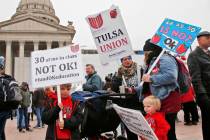Flying again: 90-year-old takes to the cockpit of biplane for birthday celebration
Herman Bishop of Sun City Summerlin is used to escaping the bonds of gravity to soar the skies, but on Feb. 22, his 90th birthday, he got a special treat: piloting a biplane, the kind he used to fly when he was a young pilot. It was a special opportunity for the Civil Air Patrol pilot. About 100 people — including Bishop’s wife, Geneva; their friends; fellow CAP pilots; and nearly a dozen family members — celebrated his milestone at the North Las Vegas Airport.
There, Bishop flew two planes, a Civil Air Patrol Cessna 206 and an N2S Stearman, a biplane. The biplane is privately owned.
“An open cockpit plane, that’s real flying,” he said. “ … We called them ‘Yellow Perils.’ It brought back memories. I even had a helmet on, like Snoopy.”
How often do we see a 90-year-old piloting a plane?
“It’s unusual but not unheard of,” said Carl Steinhoff, a fellow CAP pilot. “Not too long ago, out here at North Las Vegas Airport, we had a 93-year-old who was still instructing. … It’s fun to fly. It’s enjoyable and an interesting way to travel across the country and meet interesting people.”
Bill Edwards, commander of Bishop’s CAP Nellis Senior Squadron, said Bishop brought a great range of knowledge to the job.
“One of the great things about Herman is his enthusiasm for life,” Edwards said. “I had dropped by (the center), and Herman was out in the front yard playing with a remote-control helicopter and just having a ball. You would have thought he was a 13-year-old boy.”
He said Bishop was one of the first to be trained on the touch-screen controls in one of the new aircraft, something other older pilots were not so eager to embrace. Bishop not only learned it, he went on to be certified to train others.
Bishop has a long fascination with flying. As a child growing up in Louisville, Ky., he liked putting together airplane models. After he graduated from high school in 1942, he tried to join the war effort as a naval aviator, but his father refused to sign the paperwork. About a year later the Navy stepped in and overruled Dad’s resistance. Bishop was drafted.
He entered flight school, learning to fly fighter planes such as the Grumman F4F Wildcat. The speedy plane had him learning aerial maneuvers and loop-de-loops.
“We were on our backs half the time, flying upside down,” Bishop said.
He learned to land on converted steamer decks on Lake Michigan. His favorite plane was the Corsair because it was fast and maneuverable.
He never got to use those skills in battle. Bishop was aboard a carrier on his way to Japan when word came that World War II had ended.
“I really wanted to see combat,” he said and recalled an emotionally charged rallying cry learned in flight school. “They really had us hepped up.”
He elected to remain on active duty until mid-1947, after which he returned to his hometown and opened a launderette. He operated it for seven years and earned his civil engineering degree from the University of Louisville in 1953. That led to working in hydraulics. During that time, he was in the the Navy Reserve and was a part-time flight instructor and a traffic helicopter pilot. He transferred to the Army Reserve after his base in Columbus, Ohio, closed around 1959. In 1974, he retired as a “full bird” colonel, the rank right below general.
But Bishop’s love of planes continued and saw him joining the CAP in the early 1970s.
He and Geneva, married for 68 years, moved to Las Vegas about 18 years ago. She said she loves to fly with him.
“When he flew jets, I had apprehensions,” she said. “But I had faith in him, faith in the good Lord.”
As a member of the CAP, Bishop is called to take to the skies for traffic issues and to help with emergencies. One call for assistance, about two years ago, took him to the Pioche area of Nevada. Three elk hunters had gone out to scout an area, and one man got separated and didn’t return to camp. After the sheriff’s department couldn’t locate him, the CAP was called in.
“We were able to spot him from the air; he had one of those orange vests on,” Bishop said, adding how the man had personally thanked them. “He was lost for two days, and it was real cold. … The last morning he woke up and there were cougar tracks all around him.”
Most recently, Bishop flew to try to help locate two missing boaters on Lake Mead.
He’s been flying for the past 69 years, keeping his license current as long as he passes the physical. As a flight instructor, Bishop said he always stresses safety first.
He said he is considering taking off his wings for good.
“I’m thinking I just might hang it up,” Bishop said. “It’s like, ‘Where do I go from here?’ I’ll still fly Civil Air Patrol but probably as an observer or something. I did my time in the air.”
Contact Summerlin/Summerlin South View reporter Jan Hogan at jhogan@viewnews.com or 702-387-2949.
















